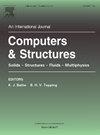用于开发用于结构分析的基于机器学习的有限元模型的框架
IF 4.8
2区 工程技术
Q1 COMPUTER SCIENCE, INTERDISCIPLINARY APPLICATIONS
引用次数: 0
摘要
本文提出了一种基于机器学习的有限元构建方法(MLBFE)来精确预测最小节点应变场。该方法首先通过子结构概念和静态凝结法建立了标准化的MLBFE模型。然后,提出了考虑(1)边界连续性、(2)应变场连续性、(3)刚体运动影响的节点位移和应变场训练数据采集方法。在此基础上,采用多元线性回归模型作为MLBFE的应变场预测模型。采用虚功原理,考虑刚体运动,计算了MLBFE的刚度矩阵和恢复力。与普通有限元模型相比,MLBFE可以用更少的元素和节点进行精细的结构模拟,从而减少了自由度和计算成本。此外,由于它不依赖于特定的结构或材料,MLBFE具有很高的通用性。本文详细建立了基于mlbfe的平面单元,并研究了单元设置对弹性结构响应计算精度的影响。验证了MLBFE对非线性结构分析的能力。本文章由计算机程序翻译,如有差异,请以英文原文为准。
A framework for developing a machine learning-based finite element model for structural analysis
This paper presents a machine learning-based finite element construction method (MLBFE) to predict a precise strain field with minimal nodes. The method first establishes a standardized MLBFE model via the substructure concept and the static condensation method. Then, a training data collection method involving nodal displacements and strain fields, and considering (1) boundary continuity, (2) strain field continuity, and (3) the effect of rigid body motion, is developed. Furthermore, multivariate linear regression is adopted as the strain field prediction model for the MLBFE. The stiffness matrix and restoring forces of the MLBFE are calculated by employing the principle of virtual work and considering rigid body motion. Compared with common finite element models, the MLBFE enables refined structural simulation with fewer elements and nodes, reducing the number of degrees of freedom and computational costs. Moreover, the MLBFE exhibits high generalizability because it does not rely on specific structures or materials. This paper provides a detailed establishment of MLBFE-based planar elements and investigates the impact of the elemental settings on the computational accuracy of the elastic structural response. The ability of the MLBFE for nonlinear structural analysis is also verified.
求助全文
通过发布文献求助,成功后即可免费获取论文全文。
去求助
来源期刊

Computers & Structures
工程技术-工程:土木
CiteScore
8.80
自引率
6.40%
发文量
122
审稿时长
33 days
期刊介绍:
Computers & Structures publishes advances in the development and use of computational methods for the solution of problems in engineering and the sciences. The range of appropriate contributions is wide, and includes papers on establishing appropriate mathematical models and their numerical solution in all areas of mechanics. The journal also includes articles that present a substantial review of a field in the topics of the journal.
 求助内容:
求助内容: 应助结果提醒方式:
应助结果提醒方式:


